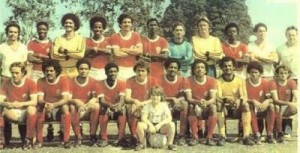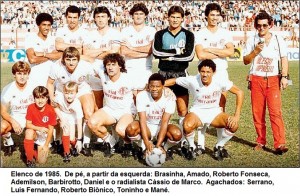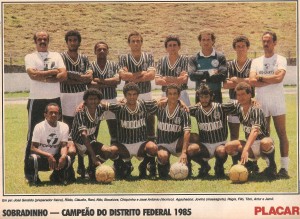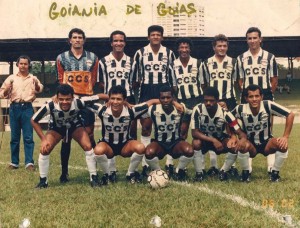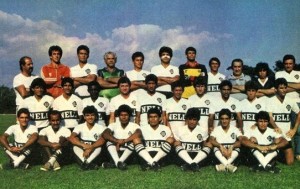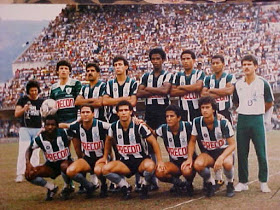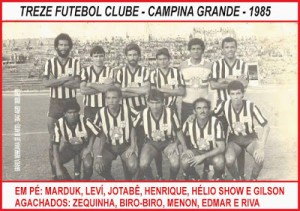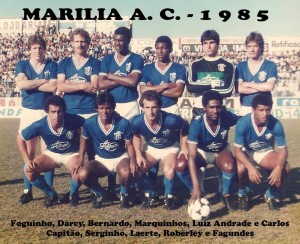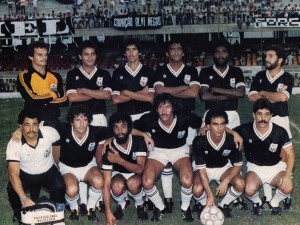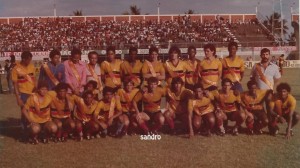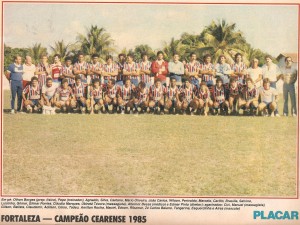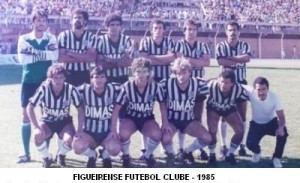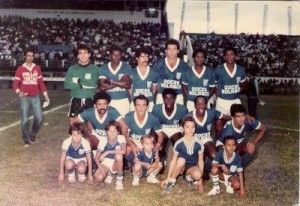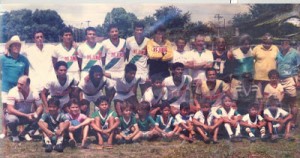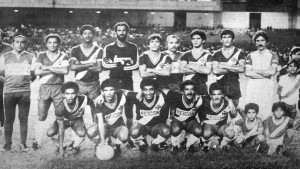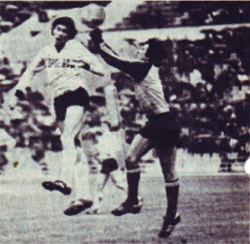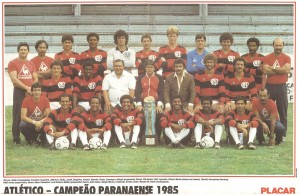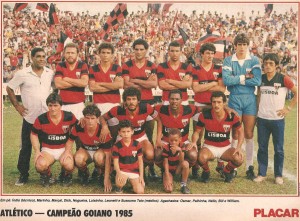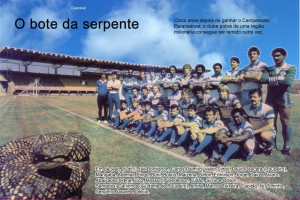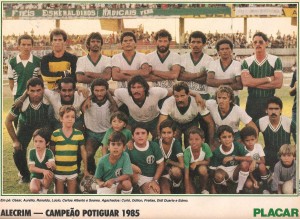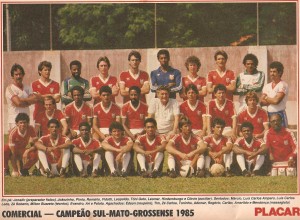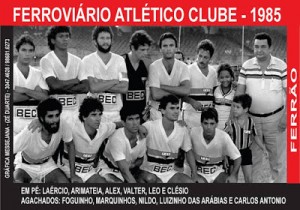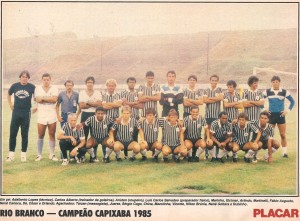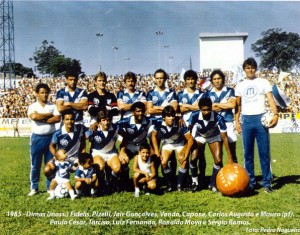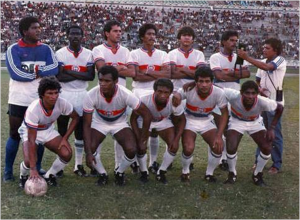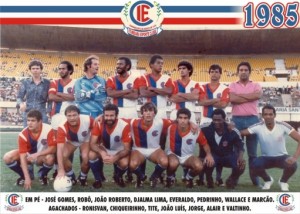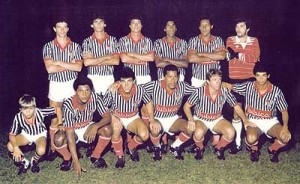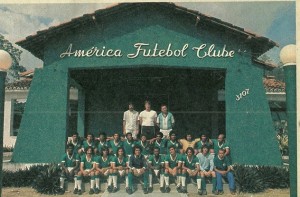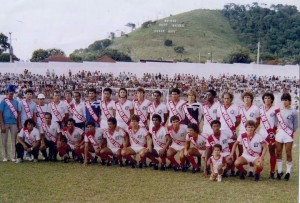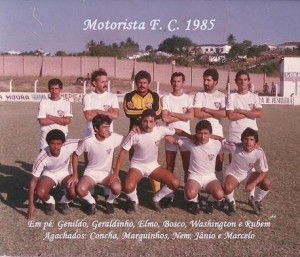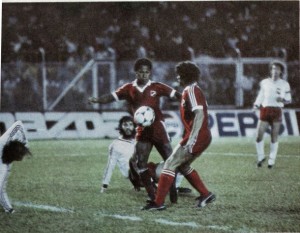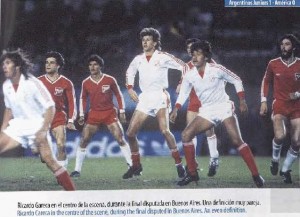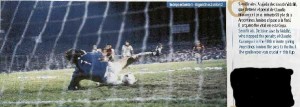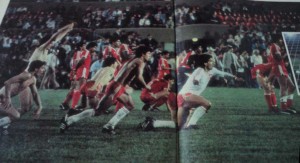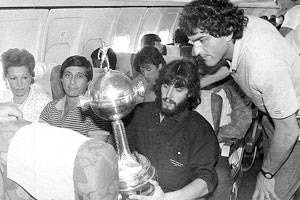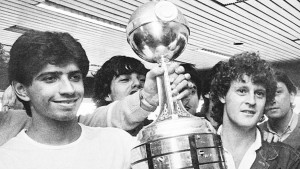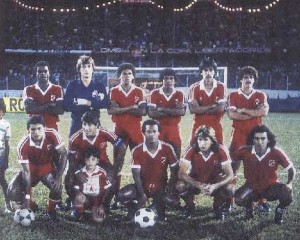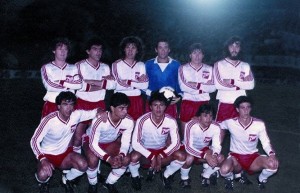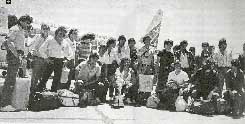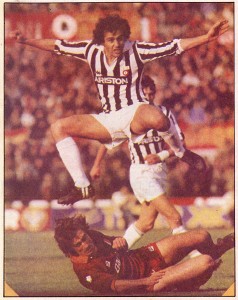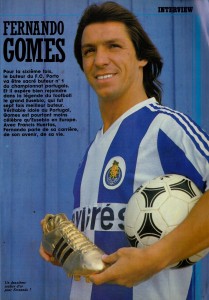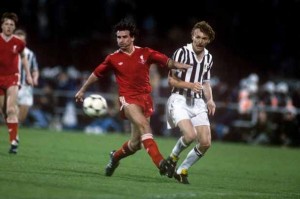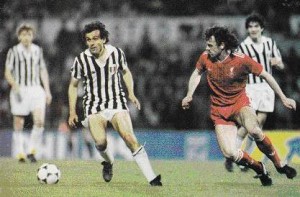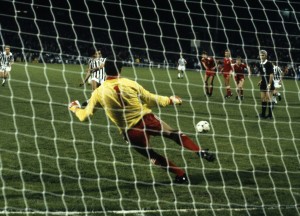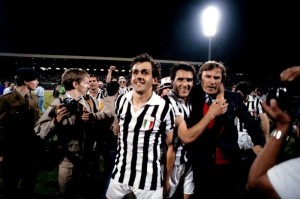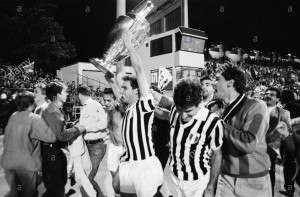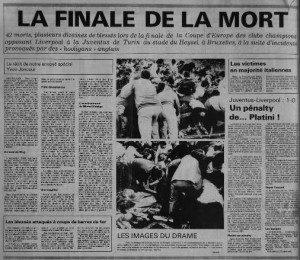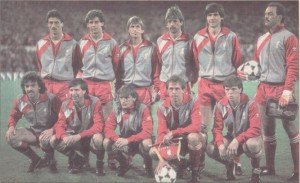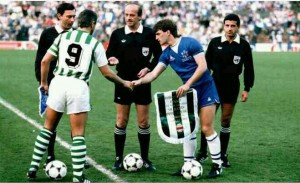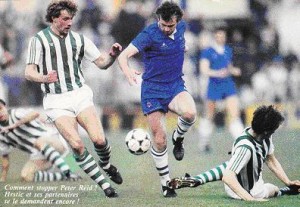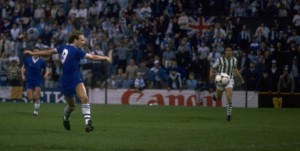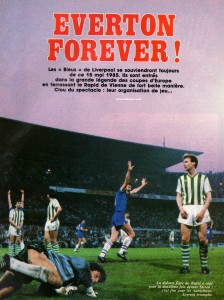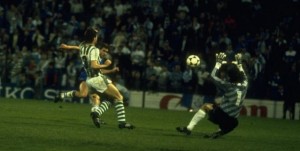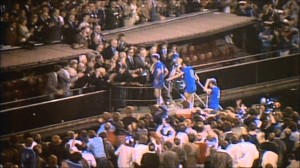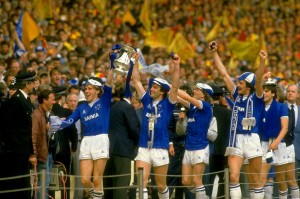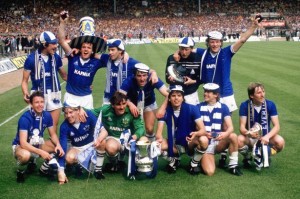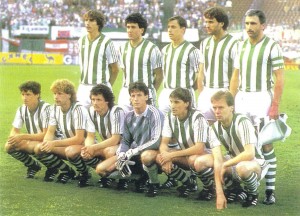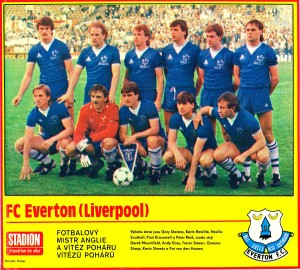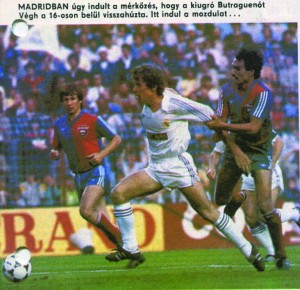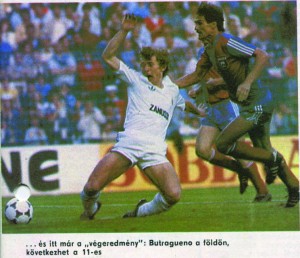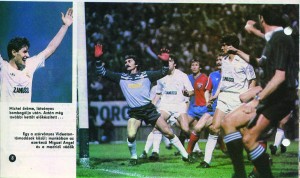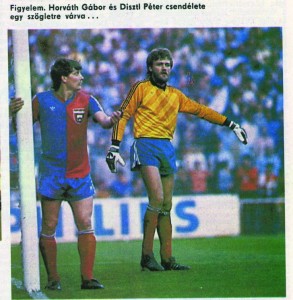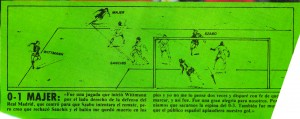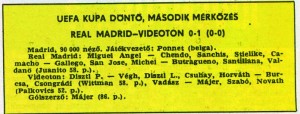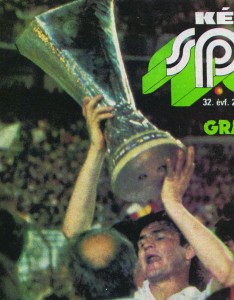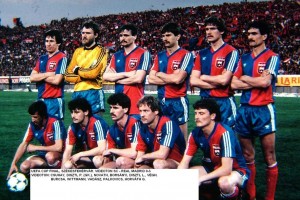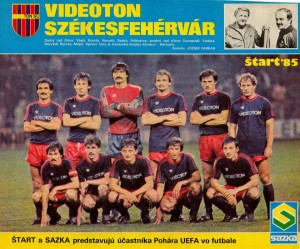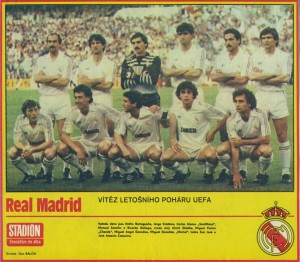The Intercontinental Cup. Or the Toyota Cup. Or Toyota European/South American Cup. Or the World Cup. What was the name? The British used the new names and counting the record only since it became sponsored by Toyota, almost alone – everybody else preferred the old name. And because of that, the records differ and opinions differ: no European team won the Toyota Cup, the British lamented . Was it possible to happen at all? So far, the European teams were not just the constant losers, but scored only one goal. Whoever counted the old record, saw even worse picture: the last European team to win the Intercontinental Cup was Bayern in 1976. So… the expectations of the 1985 issue were murky. Juventus vs Argentinos Juniors. Meaning what? The Argentines were still an enigma, known largely for having been the club introducing Diego Maradona. The rise of the smallish club – in the Argentine pecking order – started with Maradona, but they really got successful after he left. But remained unknown and European journalists went to ask Maradona to tell them about this almost anonymous team. He was not much help… he said he did not know the players, because the roster changed so much after he left and there were hardly any players he was teammate with. True… only the captain Adrian Domenech remained from the team featuring Maradona. And even he left Argentinos Juniors, however briefly. Unknown team without stars. ‘Without stars’ was the general conclusion, very unusual for South Amrican champions – and not exactly true: Argentinos Juniors had one former and one future world champion in his squad: Olguin and Batista. If the Europeans bothered to ask Argentina journalists instead of European-based Maradona, they would have learned that the team had a star – the center-forward Claudio Borghi, also a choice for the national team. Borghi was an interesting case – his play reminded of Cruijff’s: not a fixed center-forward, lurking in the penalty area and waiting for balls, but operating on the whole field, coming from the deep back, going to the wings, excellent organizer of attacks, very mobile, inventive, and creative player. But Argentinos Juniors was considered a starless team – thus, beatable? Perhaps… by now caution was the wise way in Europe. Juventus on the other hand was mighty and since it was already the 1985-86 season in Europe, even mightier – Boniek was gone from the team which won the ill-fated European final in the spring, but Micheal Laurdrup and Aldo Serena were in. Juventus, led by Platini in great form, looked much stronger than the ‘anonymous’ Argentines. There was something else, an impossible to predict and measure quality of the final in Tokyo – since it was played in December, there was no way to calculate conditions: in 1985 Liverpool and Independiente played in dry, sunny day, relatively warm for the season. As a result, the pitch was especially hard and bumpy, contributing to the boring match, which main feature were constant offside calls and professional fouls, almost every minute. This year the weather was cloudy, moist, and soon the pitch became just a field of mud. Curiously, Juventus and Argentinos Juniors were seemingly not bothered by the rough conditions and made entertaining, fast, and highly watchable, if messy, match, which even the terrible refereeing was unable to kill. It was also more vicious and rough game than the previous final – both teams hunted down key players of the oppositions, but there was little complaining, nobody was scared and rough play did not destroy the match. The mistakes of the referee did not unfocused the teams either – it was a feast of attacking football to the last minute, so unusual for teams capable to close the game and there was no trace of tactical defensive play, so beloved by Italian clubs – nothing like the stiff, cautious, and often clueless final of the previous year.
Juventus managed to deflect the initial assault of the Argentines and by the 20th minute moved into dangerous attacks itself.
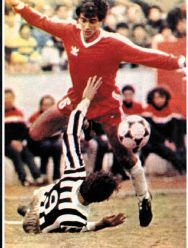
There was no mercy, let’s face it, but the Argentines were far from just trying to scare and destroy the opponents. They were well organized, eager, and skilful enough to start their own attacks as soon as getting possession of the ball. The first half ended scoreless and pretty much equal. There were already important qualities – Batista was fantastic, the key player of Juniors, covering the whole field and starting attacks from the back. Borghi was very difficult to handle and his passes was increasingly more and more dangerous. Domenech was excellent. Olguin was subtle, but always at the right place in the right time, seemingly having Platini as his charge. The Italians were not to be dismissed either – excellent Platini, tremendously dangerous Laudrup, despite the fact that Juniors singled him out for destruction and tackled viciously. The Italian defense was perfect, naturally. It was clear that both teams were determined to score, not to play tactical game, looking for some odd opportunity.
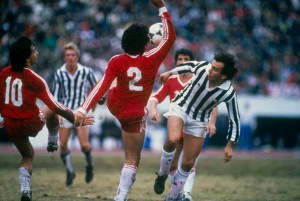
It was also clear that nobody was going to give up and there will be no mercy – hard battle by whatever means to kill danger.
In the second half Argentinos Juniors put more pressure, their attacks increasingly more dangerous, and now the referee, already suspect, made his first major mistake: Manfredonia cleared the ball with his hands in the penalty area and… a corner kick was ruled. He already dismissed Juventus’ goal in the first half – it was protested, of course, but it was rather obvious offside. Now, however, it looked like a compensation for this goal, but it was penalty. Interestingly, the Argentines did not protest and argue, but kept concentrated in the game and two minutes later Borghi saw a great opening, passed perfectly and the left winger Ereros scored. 1-0 in the 55th minute.

And immediately after that Serena almost scored after free kick taken by Platini. Wonderful moment of football. And after that, both teams flying from attack to another, the referee made a ‘small’ mistake: Platini was tackled hard, but the call went for Juniors. Soon Platini had more reasons to lose his cool and start talking to the referee, not a good sign – Volker Roth was going out of his way to inflame the players.
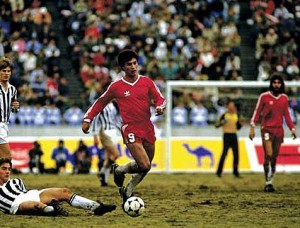
What followed was Maradona-style drible by Borghi and perfect pass to Ereros, who… hesitated and instead of shooting to the open net stopped for a bit and passed. In this split second the right winger Castro was already in offside. He scored, but the goal was disallowed. This led to Juve attack and Olguin brought down Serena in the penalty area. Age was playing his nasty tricks – Olguin was slow by now, just a tiny bit slower in critical moments. He was almost the first to the ball, but almost does not do it, so he had to use his hands to stop Serena. He pushed him just enough to unbalance Serena. Juniors protested, but this was a penalty. Platini,who made the great pass to Serena a moment earlier, stepped in and promptly equalized. However… an Italian player rushed into the penalty area before Platini kicked the ball – the penalty had to be repeated, but Roth did not bother. 1-1 in the 63th minute. Attacks continued right away and two minutes later perhaps the greatest mistake was done by Roth: after a corner kick Platini was first to the ball and scored. Roth disallowed a third goal already – presumably, for dangerously high leg – but this time it was fine goal.
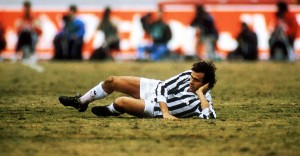
This absurdity led to rather famous picture of Platini – demonstratively musing on the referee’s idiotism. And rightly so – Roth was late in his decision. At first, the goal was allowed – Juve players celebrated, the scoreboard showed 2-1, and then out of the blue Roth disallowed it. That is, Platini was already near the central line of the field. The Argentine TV commentator could not believe it himself, which is rare reaction for one who benefits. You want to see why Platini’s goals was disallowed? Look at the second picture above – it is a split second after Platini got the ball with his chest and then kicked it above the defenders and with third kick – in the net. Yes, legs were high, but the legs of everybody. High legs, but nobody was close enough for actually kicking an opponent. It was a goal and whatever Roth was thinking, it looked like one more compensation for earlier bad decision – in this case, the omission to repeat the penalty kick from which Platini scored the equalizer.

That is the moment Platini kicks the ball in the net – it was so fast and difficult to follow here, but there was no contact between players in the whole episode. And after that… another compensation: Bonini played with his hand in the penalty area of Juniors and it was not called – out was called instead. Nothing major, not important, but it was becoming a string of bad calls.
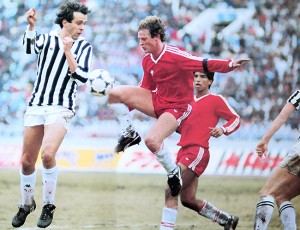
It was not to the credit of Roth the match did not deteriorated out of control – he did his best to achieve exactly that: not giving yellow cards for real and nasty fouls, but marking situations like this one, when Domenech played for the ball, came to it first to clear, but eventually bumped into Platini by inertia. Yet, not penalizing two very deliberate occasions the Argentines played with hands. No wonder both teams used Roth’s whimsicality for dirty tricks with time – and no one was punished. But neither team went berserk and forgot football – it was the players, however dirty and tough, to ignore Roth and continue to play fast attacking football.
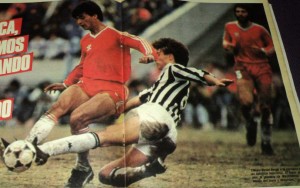
Borghi was increasingly more and more dangerous, ignoring tackles aimed at his feet, and yet another fantastic pass by him allowed Castro to score the second goal for Juniors. 2-1 in the 75th minute. Juventus immediately pushed forward. And then the 82nd minute came and perhaps the best goal of the game was scored.
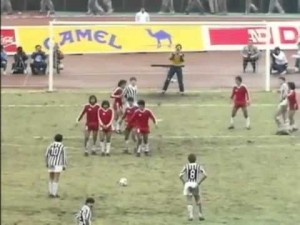
Juventus got a free kick which Platini took. Laudrup was inside the penalty area, at the right, between two Argentine defenders.
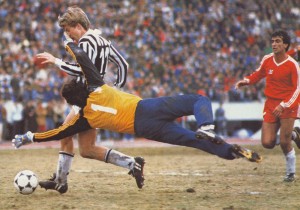
Platini passed to him, Laudrup run away of the defenders and beat Vidalle for the lose ball.

But beating the keeper brought Laudrup away from the net and too near the line – from there, at impossible angle and with two defenders already covering the net, Laudrup, almost with his back to the net at the moment and going in the opposite direction managed not only to kick the ball on target, but to find the minimal opening and the ball was in.

2-2. In the remaining minutes Batista cannoned the ball from a distance, unfortunately the ball rotated too much and went away.
In the extra time the drama continued in the same way – attack for attack, both teams making great efforts to score a third goal. In the first 15 minute Roth made his next mistake – suspect play in the Juniors penalty area,which was uncalled. It may not have been a penalty, but surely indirect kick (there was such rule back then, remember?) Nothing was called. And just before the end whistle Borghi found Ereros in great position and the winger unforgivingly missed. Second half of extra time. Brio nastily punched Domenech after the play was stopped – no reaction from Roth, but Platini was yellow-carded for talking. Of course, Platini already made a long line of misbehavior, but it was Roth who provoked such attitude. The other yellow card for something ‘bad’ – Roth missed legitimate occasions for showing cards, but distributed some for almost nothing. And until the end there were two occasions, which Juventus found more than suspect – first great attack by Cabrini was stopped in the penalty area and he was brought down. Today it is sure penalty, but back then? The ball was cleared first, the defender played for it and reached it first – he was not tackling Cabrini. Not a penalty. But the second occasion was more suspect: Vidalle clearly brought down Platini, it was deliberate, the last resource for stopping Platini from scoring. It was on the border of the penalty area and Roth opted for a free kick – the foul was committed outside. But it was inside. By centimeters, but in the penalty area. There was no time for more after that.
Penalty kicks, to top the high drama and to decide a winner between two equally deserving teams. It is a lottery, as we know. Whatever is ever said about penalty kicks, a momentary picture shows some things differently. This time there were clear mistakes by the shooters and some strange way too: Cabrini kicked somewhat predictably and Vidalle catched the ball, but was unable to redirect it enough and it ended in the net. After him Batista missed – his kick was also clearly predictable, but also too weak and Tacconi got it. Then Laudrup repeated Batista’s kick with the same result. And after him Pavoni kicked the ball directly into Tacconi, who did not have even to move. It was like players influence each other to do the same… but Juventus was leading by a goal and Platini was next, the last of the initial 5 players for the job.
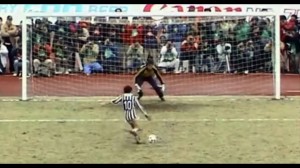
He did not miss – coolly and technically, he directed the ball in the opposite side of the direction of Vidalle’s plunge. Juventus won.
Tokyo, National Stadium, December 8, 1985. 62 000 attendants
Juventus – Argentinos Juniors 2-2 (a.e.t.), 4-2 (penalty shoot-out).
1-0 Ereros, 55th
1-1 Platini (penalty), 63rd
2-1 Castro, 75th
2-2 Laudrup, 82th
Penalties: Brio, Cabrini, Serena, Laudrup (missed), Platini (Juventus)
Olguin, Batista (missed), Lopez, Pavoni (missed).
Juventus: Stefano Tacconi, Luciano Favero, Antonio Cabrini – captain, Massimo Bonini, Sergio Brio, Gaetano Scirea (Stefano Pioli), Massimo Mauro (Massimo Briaschi), Lionello Manfredonia, Aldo Serena, Michel Platini, Michael Laudrup.
Coach: Giovanni Trapattoni.
Argentinos Juniors: Enrique Vidalle, Jose Luis Pavoni, Adrian Domenech – captain, Carmelo Villalba, Sergio Batista, Jorge Olguin, Jose Antonio Castro, Mario Videla, Claudio Borghi, Emilio Comisso (Renato Corsi), Carlos Ereros (Juan Jose Lopez).
Coach: Jose Yudica.
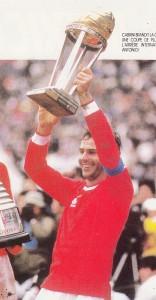
The usual happened right after – Antonio Cabrini received the Intercontinental Cup.
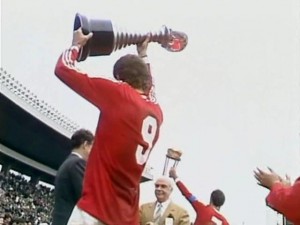
Oh, well – two cups were awarded at the time, so Juventus received them both: the old Intercontinental Cup and the new Toyota Cup.
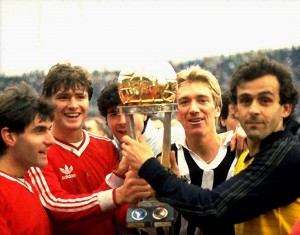
Happy Juventus – shirts were exchanged before the awarding, so the red shirts. Minus Platini, who exchanged shirts with Juniors goalkeeper Vidalle. Lucky winners of a match without a winner. Highly entertaining, very competitive, full of dramatic moments, of great moments, a show to remember. Perhaps not one of the greatest-ever matches, but a match worth watching, unlike so many finals. Both teams deserved victory. Despite the appalling refereeing, it was wonderful match – a match one wishes never to end.
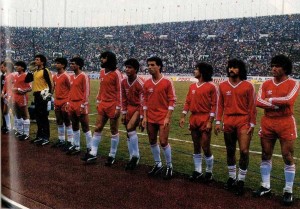
Argentinos Juniors lost and unfortunately so – they were not outplayed even for a second. From left: Domenech, Villalba, Vidalle, Videla, Olguin, Batista, Borghi, Castro, Comisso, Ereros, Pavoni.
Arguably, the best year of the relatively modest club – arguably, for playing, but certainly their best ever in terms of success. They won Copa Libertadores and were at least unbeaten at the Intercontinental final. One can be a bit sorry they did not won in Tokyo, because it was highly unlikely they will have another chance. It was fine team, contrary to the most opinions – unheralded, yes, but hardly just a bunch of mediocrities. Certainly strongly motivated, not afraid, and playing entertaining football, not for a second going into some tactical scheming to keep the result or kill time, or just playing brutally in an effort to compensate for lacking skills and feeling of inferiority. Team without stars is also relative opinion: Borghi was fantastic. So was Batista. Domenech, Olguin, Pavoni, Villalba – more than useful players. May be not first choices for the national team, but they had been included in it now and then. More than competent team, playing modern football and very well too. Yet, there were deficiencies – without remedies – aging Olguin a bit too slow, Ereros and Castro – both wingers, although full of enthusiasm and determination, had rather limited skills, which proved often fatal, for the great creative efforts of Borghi were wasted. Comisso eventually was running out of steam in the second half. Juniors fielded only Argentine players, but they had imports – the reserve goalkeeper, Cesar Roberto Mendoza, was Paraguayan, and the substitute Renato Corsi hailed from USA. That is relative… he was born in New York, but from Argentine parents and came to Argentina early, so he was a product of the Argentine youth system. No language problems either, but he – still not even 20 – was a bit limited player and also quite nervous one: he hardly helped Juniors and made too many mistakes, ending with free kicks for Juventus. Could be excused as too young and inexperienced, but no great talent – he is largely remembered as the first US player in Argentina. As for the other substitute – Juan Jose Lopez was familiar and well respected defender, who made his name playing for River Plate, but now was getting too long in the tooth and was fielded in the last minutes largely for his experience and very likely having the penalty shoot-out already in mind. May be the small deficiencies prevented Juniors from winning in regular time, but who can tell – if Roth gave the penalty in the early second half when Manfredonia handled the ball and the result was 0-0. Who knows… but what was sure: Juniors did not deserve to lose and they did not lose. They only did not win. Of this squad the most puzzling story has been Claudio Borghi, who deserves a final note: at the time, he was considered at the level of Maradona – in part, because he was also a product of the Argentinos Juniors youth system. Yet, he never became a household name. He played 18 years professional football and his resume is very impressive – 15 clubs in 6 different countries and not second-raters either. Milan, River Plate, Flamengo, Independiente, Colo-Colo top the list, but… 218 games and 28 goals for all that time tells different story. He never played regularly, in any club – in 6 years with Argentinos Juniors, he appeared in only 39 games, scoring 8 goals. For Milan he did not appear even in a single match – Berlusconi was so impressed after watching this very final with Juventus, he bought him in 1987. However, only 2 foreigners were allowed to play in Italy and Milan had van Basten and Gullit, so Borghi was loaned to Como (7 games, 0 goals). Berlusconi wanted him in the team the next year, when 3 foreigners were permitted, but Arrigo Sacchi insisted on another Dutch player and Rijkaard was brought in. No place for Borghi and he was let go. For Argentina, he played only 9 games, scoring 1 goal. Hard to tell why so big talent never made it anywhere… in part, no luck: not playing for Milan was at least partly due to strong competition. In the national team – coincidence with Maradona, no place for 2 similar players and if one has Maradona, why looking for anybody else? But the numbers suggest something else – 39 matches in 6 years for his home club, where he should have been the prime star… the Argentinian season had 40-45 championship games and Borghi for 6 years could not amass enough games even for one full season? Was he erratic or prone to injuries, or difficult character, or just overrated, more promise than delivery? The fact he did not make it in any club suggest there is some major flaw.
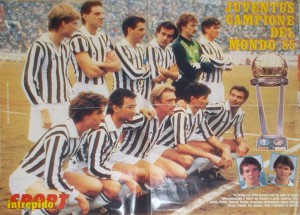
Given the match, Juventus did not deserve to lose, but was also lucky to win. World champions, standing from left: Laudrup, Brio, Scirea, Platini, Tacconi, Serena. Crouching: Manfredonia, Mauro, Bonini, Favero, Cabrini. Pioli and Briaschi in the small pictures.
To introduce Juventus would be ridiculous – perhaps there were stronger vintages, with more stars, but this happened to be the most successful vintage to date: they won the European Champions Cup for the first time and after that – the Intercontinental Cup. Platini was fantastic, Laudrup was certainly a great addition, Serena was almost surprisingly good. Cabrini and Scirea don’t even have to be mentioned – superb. Scirea unfortunately got injured and had to be replaced, but no blame for his time on the field – as ever. Excellent Bonini, unfortunate too but for different reason: he was from San Marino, thus, having no chance to play for Italy and became really famous. Brio – very solid. Manfredonia as well. The weak player was Mauro – the right winger was somewhat not good enough, but there is hardly ever a perfect squad and there was nothing to be done – Juventus had to have a right winger, especially with this unusual attacking football they were playing at the moment. And this was perhaps the biggest surprise – Juventus did not dig in, did not kill the time, did not wait for rare opportunity to strike from single counterattack – facing highly attacking minded opponent, they responded in kind, thus contributing to wonderful final. The rest is history, badly told on top of that: still and contrary to easily available records, Juventus was and is called the first European club to win ‘everything’ in a single year. Untrue – Juventus did not even come close to Ajax of 1972: did not win the Italian championship and did not win the European Supercup (not their fault, but so what? There was no final, hence, no Cup). What is true, though, Juventus became the first club to win all European trophies: the UEFA Cup in 1977, the Cup Winners Cup in 1984, the European Champions Cup in 1985. And now – the Intercontinental Cup was added, plus that it was an European victory at last – the first Toyota Cup and the first European victory after 1976.
